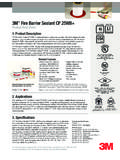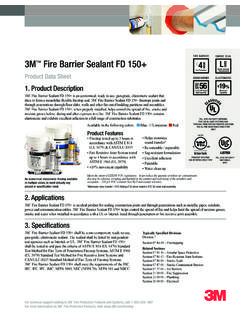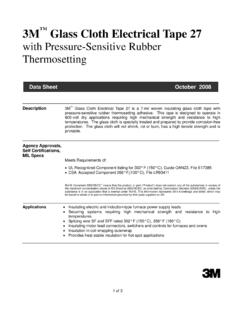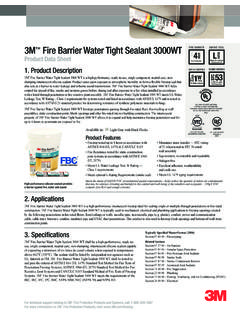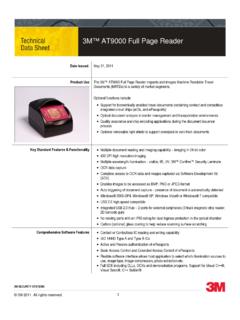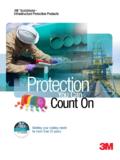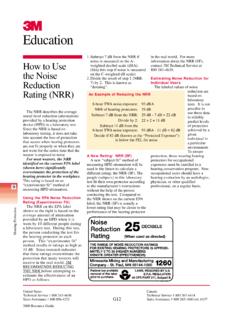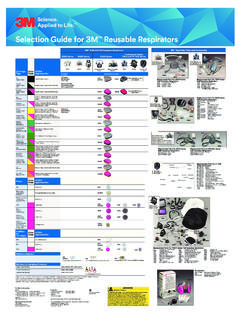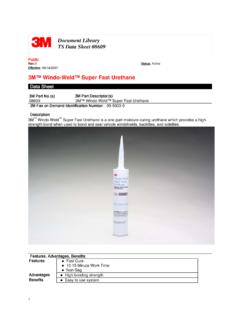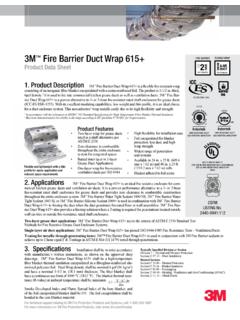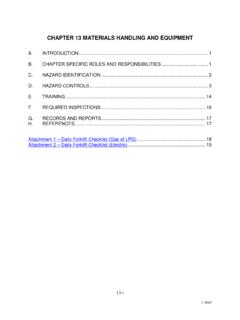Transcription of Interpretation Guide
1 Interpretation GuideThe 3M Petrifilm Enterobacteriaceae Count plate is a sample-ready-culture medium system that contains modified Violet Red Bile Glucose (VRBG) nutrients, a cold-water-soluble gelling agent, and a tetrazolium indicator that facilitates colony enumeration. 3M Petrifilm Enterobacteriaceae Count Plates are used for the enumeration of Enterobacteriaceae in the food, beverage and bottled water industries. Enterobacteriaceae are oxidase-negative, Gram-negative rods that ferment glucose to produce acid and/or gas. Enterobacteriaceae colonies will appear as red colonies associated with yellow zones, red colonies associated with gas bubbles, red colonies associated with yellow zones and with gas Count Plate2 Enterobacteriaceae Count PlateEnterobacteriaceae count = 13 Figure 1 illustrates the three types of typical colonies.
2 Sometimes gas disrupts the colony so that the colony outlines the gas 1 Enterobacteriaceae count = 0 Notice the change in gel color in Figures 3 to 8. As the Enterobacteriaceae count increases, the color of the gel lightens from purple to yellow or cream 3 Enterobacteriaceae count = 9 Figure 2 shows a 3M Petrifilm Enterobacteriaceae Count plate with a few Enterobacteriaceae colonies and a high number of non-Enterobacteriaceae, Gram-negative colonies. Do not count colonies on the foam dam since they are removed from the selective influence of the 2 Enterobacteriaceae count = 35 Figure 4 Food and Beverage Application3213 Enterobacteriaceae count = 77 The recommended counting range on 3M Petrifilm Enterobacteriaceae Count plate is less than or equal to 100 colonies.
3 Samples having counts greater than 100 Enterobacteriaceae per plate may be estimated. The circular growth area is approximately 20cm2. Estimates can be made by counting the number of colonies in one or more representative squares and determining the average number per square. Multiply the average number of colonies per square by 20 to determine the estimated count per a more accurate count, further dilution of the sample may be necessaryFigure 5 Enterobacteriaceae count = TNTCIn Figure 7, the count is so high that acid zones and gas bubbles are not easily seen. A lightening of the gel color indicates that the result is TNTC.
4 For a more accurate count, further dilution of the sample may be necessaryFigure 7 Enterobacteriaceae count = TNTC3M Petrifilm Enterobacteriaceae Count Plates with more than 100 colonies are considered too numerous to count (TNTC). When colonies are present in large numbers, plates will have a deepening of the gel color or may turn completely yellow, and either or both of the following characteristics: many small, indistinct colonies and/or many gas bubbles. When this occurs, record results as TNTC. For a more accurate count, further dilution of the sample may be necessaryFigure 6 Enterobacteriaceae count = TNTCThe 3M Petrifilm Enterobacteriaceae Count plate in Figure 8 has two characteristics indicating TNTC colonies: lightening of the gel color and many small colonies.
5 For a more accurate count, further dilution of the sample may be necessaryFigure 84 Enterobacteriaceae Count PlateEnterobacteriaceae count = 44 Artifact bubbles may result from improper inoculation of the 3M Petrifilm Enterobacteriaceae Count plate . They are irregularly shaped and not associated with a red colony. Do not 9 Enterobacteriaceae count = 29 Food particles also can be seen as dark spots but are not associated with gas bubbles or acid zones. Do not 11 Enterobacteriaceae count = 2 Food particles are often irregularly shaped or filamentous and are not associated with gas bubbles or acid zones. Do not 105 Bottled Water ApplicationEnterobacteriaceae count = 0 Gas bubbles surrounding filter do not indicate microbial growth.
6 See circle for 12 Enterobacteriaceae count = 17 Red colonies without acid or gas production (circle) are not counted as Enterobacteriaceae. Figure 14 Enterobacteriaceae count = 2 Enterobacteriaceae are identified by the presence of acid (yellow halo) and/or colony-associated gas 136 Enterobacteriaceae Count PlateReminders for Use: Food and Beverage ApplicationsStore the unopened 3M Petrifilm Enterobacteriaceae Count plate pouches at frozen or refrigerated temperatures lower than or equal to 8 C (46 F). Use before expiration date on package. It is best to allow pouches to reach room temperature before opening. 8 CPetrifil m Colif or mSeal by folding the end of the pouch over and applying adhesive tape.
7 To prevent exposure to moisture, do not refrigerate opened pouches. Store resealed pouches in a cool, dry place for no longer than four the 3M Petrifilm Enterobacteriaceae Count plate on a level surface. Lift the top film and with the pipette perpendicular to the inoculation area, dispense 1mL of sample suspension onto the center of the bottom flat side down, place 3M Petrifilm Spreader on top film over apply pressure on 3M Petrifilm Spreader to distribute inoculum over circular area before gel is formed. Do not twist or slide the spreader. Lift 3M Petrifilm Spreader. Wait a minimum of 1 minute for gel to the top film down onto the sample gently to prevent trapping air bubbles.
8 Do not let the top film drop. Incubate plates with clear side up in stacks of no more than 20 plates. It may be necessary to humidify the incubator to minimize moisture loss. See product instructions for third party validated Petrifilm Enterobacteriaceae Count Plates can be counted with the 3M Petrifilm plate Reader, a standard colony counter or other illuminated magnifier. Colonies can be isolated for further identification. Lift the top film and pick the colony from the s phosphate-buffered dilution water, peptone salt diluent, peptone water, buffered peptone water, dipotassium hydrogen phosphate solution, saline solution ( ), bisulfite-free letheen broth or distilled water.
9 For optimal growth and recovery of the microorganisms, adjust the pH of the sample suspension to to not use diluents containing citrate, bisulfite or thiosulfate with the 3M Petrifilm Enterobacteriaceae Count Plates; they can inhibit growth. If citrate buffer is indicated in the standard procedure, substitute with one of the buffers listed above, warmed to 40-45 Appropriate Sterile Diluents7 Reminders for Use: Bottled Water ApplicationsFollow steps 1 and 2 of Food and Beverage Application Reminders for Use. 8 CPetrifil m Colif or mStoragePlace 3M Petrifilm Enterobacteriaceae Count plate on a flat, level surface.
10 Lift the top film and dispense 1 mL of an appropriate sterile hydration diluent onto the center of the bottom film. Appropriate sterile diluents include sterile water, deionized (DI) water and reverse osmosis (RO) mLRoll the top film down onto the sample to prevent trapping air bubbles. Place the 3M Petrifilm Spreader with the flat side down on the center of the plate . Press gently on the center of spreader to distribute the diluent evenly. Remove the spreader and allow the plates to remain closed for a minimum of 1 hour before membrane filtration of water samples use a 47mm, micron pore size Mixed Cellulose Ester (MCE) filter.
